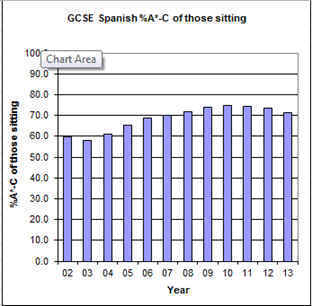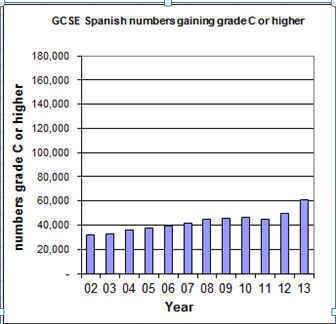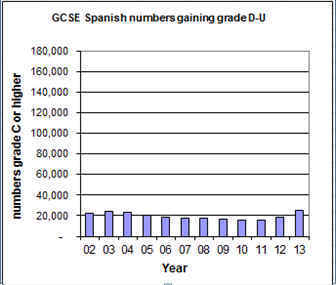ALL
London branch 
ALL
London branch |
Last update: 29/09/2013 |
GCSE ML numbers and grades - Sept 2013
Please download this page here as a word document for a neater version. Documents and spreadsheets relating to “severe grading”
are at the ALL London website:
www.all-london.org.uk/severe_grading.htm ASCL,
ALL (Association for Language Learning) and ISMLA (Independent Schools Modern
Language Association) have worked closely together on these matters which affect
state and independent sectors Notes: Statistics in this paper are based on the JCQ
tables for 'England' issued each August. GCSE numbers
·
The English Baccalaureate (EBacc)
was announced in Jan '11 so its first main effect was on those pupils choosing
options in Year 9 in Spring 2011, with the GCSE course starting in Sept ’11
and taking exam in Jun '13. From 2002-12, there was a steady decline in the total numbers taking GCSE Modern Languages, with sharp declines for the exams taken in June 2004 - 06; as a result, the numbers are around half of those in 2002
·
Numbers in French
increased by 17% from 2012 to 2013 and are now roughly the same as they were in
2010. German in 2013 saw an increase of 10% on 2012. Although
the 2013 numbers are slightly up from 2011, they have not recovered the levels
of 2010. There was a dramatic increase of 27% in entries in Spanish in 2013 compared with 2012. In 2011, both Spanish and German had approx 60,000 entries, but Spanish has jumped to 86,000 by 2013. The numbers taking Spanish and some other languages (with many native speakers) increased since 2002 (increase in Spanish = 32,000), but are far outweighed by the decline in French and German. ·
There will be many theories about this variation amongst languages
in response to the EBacc announcement, and it will be of interest to get more
detailed analysis whether through "Language Trends" or when the full
Performance Tables are published by the DfE in January 2014 .
GCSE grading and numbers including A*-C and D-U
·
The decline in numbers over the years has been particularly
marked in lower-attaining pupils at GCSE French
In 2013 the percentage
of A*-C has dropped, and is lower
than in 2010, BUT the number getting
A*-C has increased. There are noticeably more D-Us, even when compared against 2010 The existence of Severe Grading in Modern Languages is now
well-established but we want to be confident that the situation has not
worsened. We will need to wait until the prior attainment information is
published in early December to see how these apparently conflicting statistics
can be reconciled. There is
naturally a variation every year at a school-to-school level, and it is always
difficult to establish a general picture from individual cases, so we must wait
for the national picture. More detail in French
The complex pattern within grades between 2010 and 2013 is clear in the A-Cs in French. Look at the cumulative numbers getting each grade. (e.g. A* 2010: 17,635 2013: 15,852, whereas cumulative A*-C is virtually the same)
Note that border lines are decided for A/B, C/D and F/G and
other grades are extrapolated from these. As
a result, if a C/D borderline is changed, this will have an inverse effect on
the number of A*s. This was
highlighted when the Welsh government said in August 2012 that the C/D
borderline in GCSE English had to be changed in order to allow more candidates
to gain a C grade. This led to an
automatic drop in A* (requiring exceptional action for affected candidates)!!!
The rise of 2% in the cumulative
% at grade F, shows that even fewer candidates were being entered and gaining
grades F & G. In 2010 and before, candidates who could have gained a C
grade had been allowed to drop the subject, but with EBacc measure, schools and
parents encouraged more pupils who could get a C grade to take the subject.
By and large, the increased number represents the number who had dropped
the subject since 2008 (those who could gain a C grade).
The EBacc did not give an incentive to candidates unlikely to reach a C
grade to take the subject. German
There was a sharp drop in overall numbers from 2010 to
2011, small drop to 2012 and then a rise in 2013 to around the level of 2011,
but well below the level of 2010 and before.
Because the %A*-C has remained reasonably constant between
2010 and 2013, the numbers getting A*-C and D-U have fallen and risen in line
with the fall and rise in the overall numbers sitting German Note that the graphs of numbers gaining A*-C and D-U in
French, German and Spanish all have the same vertical scale (up to 180,000) to
enable valid comparison to be drawn.
|
 |
 |
 |
However, the %A*-C dropped from 75% in 2010 to 71% in 2013.
Even so, the total numbers gaining A*-C in Spanish rose from 46,685 to
61,199. The changing percentages
appear to be reasonably evenly spread across the grades.